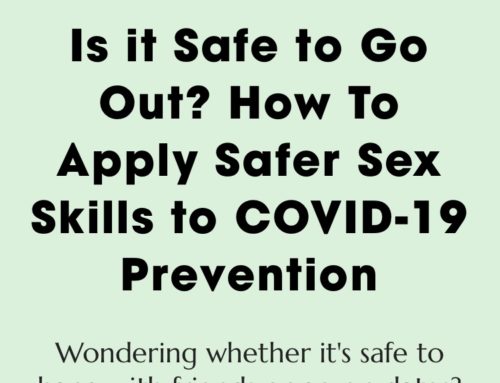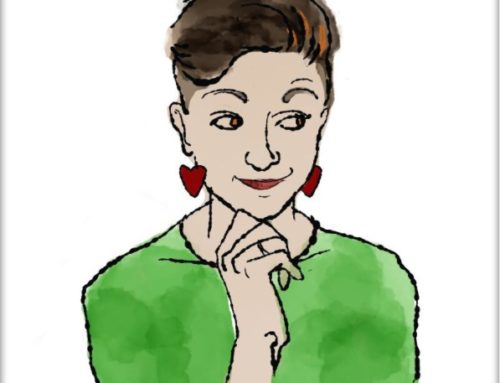The day national marriage equality passed I sobbed into my boyfriend’s shoulder in bed for half an hour. My shoulders heaved and my dog looked worried as he frantically tried to gain access to my tears so he could lick them away. When I managed to stifle my drooly crying hiccups for long enough, I lifted my head from his shoulder, a wobbly tightrope of snot connecting his clavicle to my septum ring. “I don’tttt — {drooly hiccup} — want to be straight — {drooly hiccup} — FOREVER!!”, I sobbed dramatically, before jamming my face back into my own snot-pool, now running down his arm.
Patrick and I had just gotten engaged — in fact, our engagement party was set to happen that very night. Though I had dated cismen up until I was 21, for the nine years prior to my meeting Patrick, I had primarily dated queer women — I even married one. Though I had found that one’s “bisexual” label magically turns into a “lesbian” label in the public eye once you have a “lesbian wedding”, this never bothered me much; I had always felt so special with my membership in this group of gender-fucking, pierced, half-shaved-headed hotties we call the LGBTQ community that I barely kissed the straight community goodbye when I left it in 2006. I more-so quietly stepped into my jeans and snuck out the next morning.
And then there was Patrick. He came out of left field to say the least (I mean, I met him when he was on a date with another woman) as did my borderline-insanity-inducing love for him. Four months later we were engaged and a month after that marriage equality was passed and I was smearing my boogers all over him, crying both from being overjoyed about marriage equality and from being overwhelmed about my forever-straight fate.
The Other Side of Bi
While I’ve always conceptualized the bisexual experience as a two-way swinging door, I’ve found that most people find it more enjoyable when you push that door towards women. The queer community is all “Cool! Welcome to the fold!” and the straight community is all “Ah, so French! So titilating!” as fantasies of bi-curious pillow fights abound.
When you decide to go back through the doorway however, back to cis-manlandia, people are more baffled than bisexually bewitched. The cis-dudes are all “WTF?! Since when do you date men? Why didn’t I get a shot?” and the queer women are all “Another one bites the dust” and the reception from the straight community is all *shrug*, without a welcome banner in sight.
The thing about bisexuality is that it’s often socially determined by the body parts and gender identity of your partner. No matter how many times you repeat “I’m queer. I’m queer. I’m queer.” to yourself in your head, when you walk through life holding your cis-male partner’s hand, your attempts at making meaningful eye contact with the only other queer couple at the party are failed, or your boyfriend’s friends are left scratching their heads all “I dunno man, I think Patrick’s girlfriend might be gay”. No matter who you date, half of your sexual identity, half of who you are, is invisible.
For many of my peers, coming out was a long, painful process, starting with the realization of same-sex attraction at an early age, followed by a well-planned-out coming out process. Many’s coming out histories involve violence and abuse both physical and psychological. In my experience, my same-sex desire developed within a larger culture of understanding and acceptance. I grew up in notoriously lesbian-friendly Northampton, Ma with liberal parents who already had many LGBTQ friends and by the time I started dating women, I was attending Hampshire College, also notoriously liberal with a thriving queer community already established.
In fact, “coming out” was never a process I really had to do — I simply brought my first girlfriend to a family party and introduced her as such, simply started holding her hand on campus without fanfare. I never felt that I had unspoken same-sex desires as a younger teen and if I did, I certainly never felt guilty or afraid of those feelings.
Living in these communities is a privilege. Passing as a dominant identity (whether it’s as male, as straight, as white, as wealthy) is a privilege stacked with socially constructed perks. My personal experience of coming out as queer without the pain and loss associated with so many LGBTQ people’s traditional coming out stories is a privilege. But the pain of watching nine years of my meaningful queer sexual and romantic history being erased and the loss of my social membership in the queer community when I started dating my now-fiancee was and is very real. Re-coming out as bisexual by starting once again to date cis-men is confusing.
Loving On & Bumming About Boys
Traditional stage theories of identity development dictate a linear story of one’s sexual identity: girl meets boy and falls in love; girl goes to liberal arts college; girl starts watching the L-word; girl makes out with her “lesbian friend”; girl breaks up with her boyfriend; girl gets a new short haircut; girl dates her first girlfriend; girl is now a lesbian; fin. Linear stage theories imply that once an individual achieves a full awareness and expression of her sexual desire, stability occurs and no more change happens. This is what the traditional coming-out model is based on. You realize you’re gay, you come out, and then you’re gay forever.
In convincing contrast to this, Lisa M. Diamond, in her 2007 study of the development and expression of female same-sex sexuality, argues that multidimensional development theories such as Dynamical Systems Models more accurately represent the seemingly random spectrum of female same-sex sexuality development. Dynamical Systems Models were originally designed by mathematicians and physicists to model complex physical phenomenon in the natural world. These models are used to explain how complex patterns emerge, stabilize, change, and then restabilize over time. Diamond (2007) shows in her 10-year study of young, non-heterosexual women, that this is precisely what female same-sex sexuality development is likely to do.
In her study of 89 non-heterosexual-identifying women, Diamond found female same-sex sexuality to be particularly fluid. Specifically, her research revealed female same-sex desire to be more fluid than male same-sex desire, featuring drastic, often late-blooming, and seemingly abrupt changes in female sexual desire both in strength-of-desire (how attracted they felt to men or women) and object-of-desire (such as women moving from opposite-sex attraction, to same-sex attraction, and then back again).
Much research has shown that the male model of sexual orientation — which often features linear shifts in identity — cannot be simply overlayed onto the female sexual experience. However, our patriarchal, heteronormative concept of sex and sexuality continues to imagine female and male sexuality as two sides of the same coin. Studies of both adults and adolescents have shown that women are more likely to report bisexual attractions than to report exclusive same-sex attractions, whereas the opposite pattern is found in men. While many gay- or bisexual-identified men recall experiencing their first same-sex attractions a few years prior to puberty (similar to the age at which most heterosexual children recall their first other-sex desires), many women report that they didn’t experience same-sex attractions until adulthood, instances which are described by women as situational, interpersonal, and contextual rather than pre-determined or gradually developing as with men. Though many women’s same-sex attractions were described as emerging “suddenly” and “by accident”, two thirds believed they were born with their particular sexual orientation (only 18% believed their same-sex attraction to be a choice).
Even more interestingly, Diamond’s study found female sexuality to be defined by continuous change. By the end of her 10-year study, 10% of participants who had identified as lesbian had settled into long-term relationships with cis-men while 60% had experienced sexual contact with a cis-man and 36% reported romantic relationships with cis-men.
Women’s descriptions of their unexpected shifts back to straightsville were often illustrated as being similarly abrupt and as changes they had no control over. As one participant elaborated, going back to the cis-boys was a bit of a bummer: “I’ve kind of straightened out! I still call myself bisexual but I’m on the edge of heterosexual, which I’m not pleased about. I never really wanted to be heterosexual but I don’t have much choice in the matter…I think sexuality changes, but I don’t have any idea what causes those changes” (Diamond, 2007, p. 148).
Diamond herself reports that “women who reinitiated other-sex behavior typically described these experiences as feeling fundamentally different from the forms of heterosexuality they had pursued prior to ever questioning their sexuality. Hence, they did not perceive themselves as going back to men but, rather as moving forward toward new forms of sexual and erotic experiences” (Diamond, 2007, p. 148). Diamond’s study has shown me that I’ve been doing it all wrong. Bisexuality — and indeed, sexuality — is not a swinging door which transports us from one side or the other. In fact, female sexuality itself is more of a hallway, full of trap doors, entrances, exits, stairwells and maybe even the fire escape or two. There is no going back to old forms of sexuality and sexual identity, there’s only the new and exciting road ahead to traverse.
Bye Bi Binary
In the near-decade since Diamond’s study was conducted, the binary system of identity has been slowly dying. Binaries do nothing but attempt to stuff our multi-layered human experiences and identities into two rigid categories (gay or straight? male or female? kinky or vanilla?), leaving no room for variation when the human sexual experience is nothing but variant. The image of sexuality as a swinging door, with one side or the other, is broken and does nothing for our modern queer (or straight!) communities but make us feel like we don’t fit in. In its place thrives the spectrum of sexuality, sexual experience, gender identity, sexuality identity and even the meaning of bisexuality itself. Legal marriage, once defined by the binary of “one man and one woman”, is now celebrated by the entire spectrum of what makes up love and commitment.
My fiancee Patrick is one of those cis-dudes who’s a feminist dude who doesn’t need to tell you “I’m a feminist dude”. Patrick cried on marriage equality day, too, (actually all day long on marriage equality day), simply because of his sheer, genuine love of love and equality. I’m the luckiest lady alive to be marrying him, no matter what he’s packing in his pants, or what his preferred pronouns are. Gently breaking my snot-trapeze from his body, he laughs as he tells me “Babe, you’re not straight. You’re queer”. “Yeah, I know,” I sniffle, finally finding my way to a Kleenex. “For now”.


